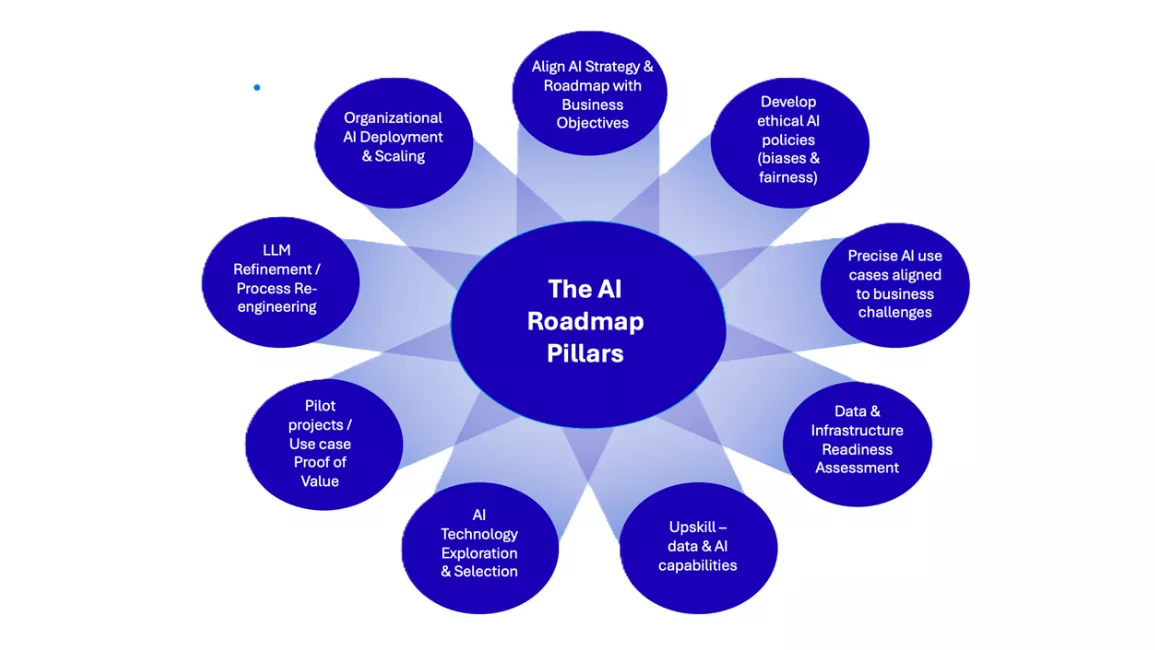
Developing an Artificial Intelligence (AI) strategy
Embracing the future of construction through AI.
By Dave Philp FCIOB FCInstCES FICE FRICS and Charlene Burkmar*
As construction continues to embrace innovative ways of using data and technology, the integration of AI has emerged as a powerful catalyst for efficiency and positive impact, which is critical to remain competitive on a local and global scale.
The CIOB AI Playbook published in June highlighted the need for organisations to develop a comprehensive AI strategy as a priority. This blog explores key steps for developing an AI strategy, tailored to the construction sector.
Understanding the potential of AI in your organisation
AI technologies and the smart use of data has the potential to revolutionise various aspects of construction and asset operation by streamlining workflows, reducing costs, and improving decision-making. Potential use cases include:
- Project planning and scheduling: Analysing historical data and predicting potential delays, for more accurate scheduling and resource allocation.
- Design optimisation: Generating multiple design alternatives based on specific criteria, for selection of the most efficient and cost-effective option.
- Predictive maintenance: Monitoring of equipment to predict maintenance needs, reducing downtime and extending asset lifespans.
- Safety management: AI coupled with computer vision can identify safety hazards in real-time, enhancing on-site safety and reducing the risk of accidents.
- Quality control: AI can automate quality inspections, by analysing images and data from site, ensuring required standards and specifications are met.
- Improved end results: Including reduction in waste, energy and environmental impact, improved asset management, increased usability and reduced risks.
To harness the full potential of AI, construction organisations must develop a well-defined strategy that aligns specifically to their critical needs and objectives.
Developing an AI strategy
An AI strategy should outline the mid to long-term vision and goals, alongside an implementation plan (including a short-term tactical discovery and experimentation), aligned to objectives and use cases, with tangible milestones. This should include:
Vision and precise goals: Define the vision and outcomes with SMART Key Performance Indicators (KPIs) that align and weave into to strategic business objectives. Consider ethical and value driven approaches.
Use cases: Identify specific AI use cases that will deliver tangible benefits based on business or project challenges and required outcomes.
Assessment of current level of data maturity: Prior to defining the strategy it is important understand the current level of maturity in relation to AI and its data science themes to build the appropriate and proportionate roadmap.
Expert advice: Engage with others in your team, especially legal and IT (it is important to know and mitigate risks or implications). If practical, reach out to AI experts, data scientists, and technology partners.
Small scale trials
Before large scale deployment, invest in a pilot project or proof of concept (POC) on a specific use case to understand, validate, demonstrate and enhance the value with iterative learning. The POC will be a quick tactical delivery, at limited risk, and representative of the approach taken to wider scale investment. It is effectively a small-scale strategy incorporating:
- Definition of use case, with quantifiable benefits and return on investment measures to project the impact if scaled.
- Selecting a pilot project, that is manageable in scope and provides valuable insights into practical applications. Alternatively create a “sandbox” with data from a previous project to use if a live project is not practical.
- Data Improvements - quality data is the fuel to power the AI engine. Use cases will only be achieved with the right data, infrastructure and algorithm strategy. The POC provides the opportunity to test the quality and reliability of the data.
- Appropriate technology or application selection to support the pilot and their use cases.
- Analyse results, collect and analyse data from the pilot project, comparing results against the defined objectives and KPIs to determine the value.
- Refine and improve by reviewing the outcomes, lessons learnt and improvement areas. This requires a transparent process with established feedback loops that inform the strategy.
- Effectively communicate the success of the pilot project, highlighting the tangible benefits and potential for scaling AI.
Implementing a wider strategy
Having delivered the POC and measured the outcomes and learnt the lessons the more detailed strategy can be created. This should cover:
An AI foundation: Develop the principles and large language models required for large scale roll out, aligned to organisational maturity and future state goals.
Resource allocation: Identify the necessary resources, including budget, personnel, and technology. Ensure your organisation is proportionately equipped.
Data assessment and improvements: Establish the data strategy, governance and improvements aligned to the use cases.
Technology infrastructure: Assess and upgrade your infrastructure to support AI applications.
Organisational and behavioural change: To achieve the results everyone in your organisation and supply chain must be engaged in utilising the capability. Foster a culture of continuous learning.
Training and development: Invest in data science literacy, training and development to arm employees with appropriate skills and knowledge.
Implementation plan: Outline the steps, timelines, and milestones. Ensure that the plan is flexible and adaptable to evolving needs and challenges.
Delivery: Work across the organisation and your supply chain to roll out the technology and data improvements at scale. This will be iterative with continual review, assessment and agility becoming business as usual.
Learn more
Conclusion
By developing a strategic approach to AI adoption, construction organisations can benefit with greater transparency, information, decision making, planning, risk mitigation, and rapid response to ensure the programme stays on schedule and a quality output is achieved.
Identifying use cases, establishing proof of value, and creating a comprehensive roadmap are essential steps in this journey. A good AI strategy will ensure that your AI journey brings tangible business benefits, is adoptable and will evolve over time.
*Dave Philp FCIOB FCInstCES FICE FRICS
Chair, CIOB Innovation Panel
Chief Value Officer, Cohesive
Charlene Burkmar
CEO, Vision Into Reality

Contact our Press Office
We welcome requests for information, comments and interviews from journalists across the globe so please feel free to contact us: